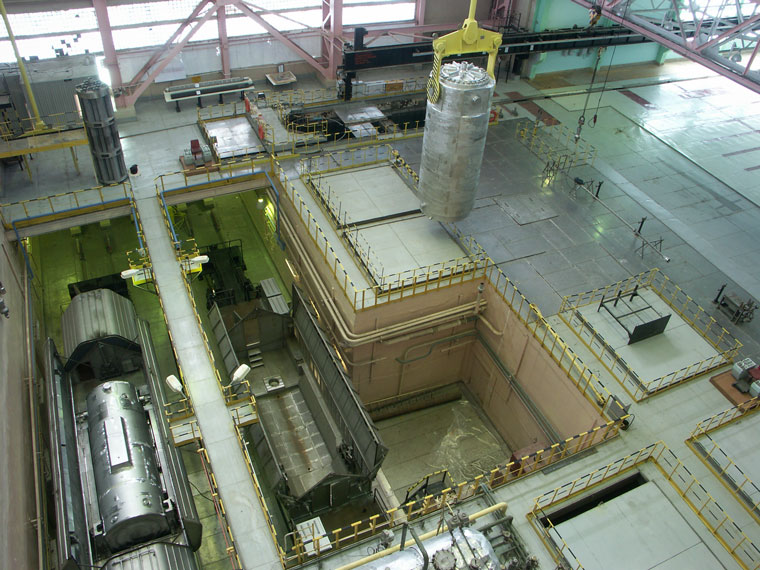
Targets overachieved
back to contentsProgram results are impressive as targets were overachieved despite financial cuts. According to Alexander Abramov, Rosatom Deputy CEO for Public Policy on RAW, SNF and Nuclear Decommissioning, the program efficiency reached 108.5%, with over 300 measures taken on 400 sites. “Few federal programs have demonstrated similar results. Let alone the fact that program investments were reduced by 10 billion rubles,” he stressed.
Solid performance was supported, Abramov says, by reasonable management decisions, establishment of operational excellence centers, and joint efforts of R&D institutions, Ministry of Industry and Trade, Russian regulator Rostekhnadzor and other program stakeholders. Over the past eight years, the company developed more than 50 back-end technologies, including 10 SNF reprocessing techniques.
Over 4.2 billion rubles was saved by promoting competition among suppliers. Abramov explains, “When the program just started, it was not unusual to have only one bidder. Conversely, suppliers are now competing for every program-related contract.”
The price of third-party services has reduced, too. Site rehabilitation is now four times cheaper than it used to be. The price of decommissioning services and spent nuclear fuel transportation is respectively 2.5 times and 3.2 times lower. “We used to pay 722,000 rubles per ton for the SNF transportation while today it costs about 200,000 rubles. Site rehabilitation was almost 10,000 rubles per square meter, but today the cost is less than 2,000 rubles” Abramov cites an example.
Spent nuclear fuel
Spent nuclear fuel forms a major part of nuclear legacy. The SNF management concept preceding the federal program assumed the long-term SNF storage in spent fuel pools and subsequent ‘wet’ storage at the Mining and Chemical Plant (MCP), with only a small portion of spent nuclear fuel reprocessed at Mayak. The situation was unlikely to change without new reprocessing facilities and infrastructure. The program began with identifying the amount of spent and defective nuclear fuel. The next step was to establish an SNF management cluster, which included several facilities at MCP and Mayak. Dry cask storage at MCP was at the heart of the entire project. “It was an extremely difficult job. We had to synchronize the commissioning of MCP facilities, fuel preparation units at nuclear stations and logistics in order to solve the existing problem of over-packed spent fuel pools at power plants. At present, RBMK spent fuel is regularly transported for storage from the Leningrad and Kursk nuclear stations. Transportation of spent nuclear fuel from the Smolensk NPP is scheduled for 2016,” Abramov says. Some part of RBMK spent fuel is not suitable for dry storage. “It is about 5% of the total amount,” explains he. “The reprocessing technology for this fuel has been piloted at RT-1 facility at Mayak.” Starting from 2016, RT-1 will handle up to 30 tons of spent fuel annually.
Spent nuclear fuel from research reactors has been piled up for decades in large R&D centers, such as Research Institute of Atomic Reactors (RIAR), Leipunsky Institute of Physics and Power Engineering, and Kurchatov Institute. Much effort was invested in SNF analysis, unloading and transportation technologies. A good example is RIAR’s main storage pool, which was filled up to more than 89% of its capacity. Thanks to an efficient transportation solution, RIAR alone was able to send 2,653 irradiated fuel assemblies for reprocessing while the total amount of spent fuel reprocessed or put into storage under the Nuclear and Radiation Safety Program approached 30,000 irradiated fuel assemblies.
According to Alexander Abramov, nuclear decommissioning targets were overachieved as fifty-three radioactive facilities were decommissioned instead of forty-two planned. The largest facility, EI–2 commercial uranium-graphite reactor at the Siberian Chemical Plant (SCP), was decommissioned in September. Its safe storage is intended for more than 1,000 years. Other decommissioned facilities include research reactors and commercial buildings and structures.
International relations
Some legacy-focused projects of the federal target program were linked with international nuclear legacy management efforts. One of them was decommissioning of Volodarsky floating maintenance base constructed in 1928 and converted into a berth-connected ship in 1991, with over 1,200 cubic meters of solid nuclear waste on board. Volodarsky was dismantled and docked for long-term storage in Sayda-Guba, where the storage facility was constructed as part of the international legacy management effort. “The facility in Sayda-Guba will receive another vessel, Lepse floating maintenance base, for decommissioning next year,” Abramov adds.
Decommissioning and transportation of the RITEG radioisotope thermoelectric generators is not an easier project. “By now, we have delivered 394 radioisotope generators for dismantlement and storage” he says. “These military units were dismantled as part of global cooperation. The Government has financed the disposal of fifty civil RITEGs, with two more to be decommissioned later this year.”
Plans
A new radiation safety federal program will cover a period from 2016 till 2030. Its draft is now awaiting the Government’s approval. The program sets new targets in SNF and RAW management, decommissioning of nuclear facilities, and site rehabilitation. The plans are to tackle a half of all the existing legacy issues and transport most RBMK-1000 spent fuel to the centralized storage site by 2030. “We will launch the National RAW Management System in the next five years. There is every reason to believe that the nuclear and radiation safety program will offer a comprehensive solution for legacy issues and help maintaining SNF/RAW management and nuclear decommissioning systems,” Abramov concluded.




